Comprehensive Analysis of Chennai's Public Transportation System
VerifiedAdded on 2022/05/11
|21
|5967
|46
Report
AI Summary
This report provides a comprehensive analysis of Chennai's public transportation system. It begins with an introduction to the city's historical context and development, highlighting the importance of a robust public transport infrastructure for its growing population. The report then delves into the current state of Chennai's public transport, including MTC buses, suburban trains, and metro services, while also outlining the existing problems such as timetable issues, lack of coordination, longer travel times, traffic law enforcement, road congestion, and infrastructure limitations. The report explores alternative solutions, including enhancing accessibility, improving affordability, and integrating different modes of transport. It also proposes the implementation of a Bus Rapid Transit (BRT) system and discusses the associated costs and funding sources. The report concludes by emphasizing the need for strategic planning and investment to create a sustainable and efficient public transportation system that caters to the needs of all socioeconomic groups in Chennai.
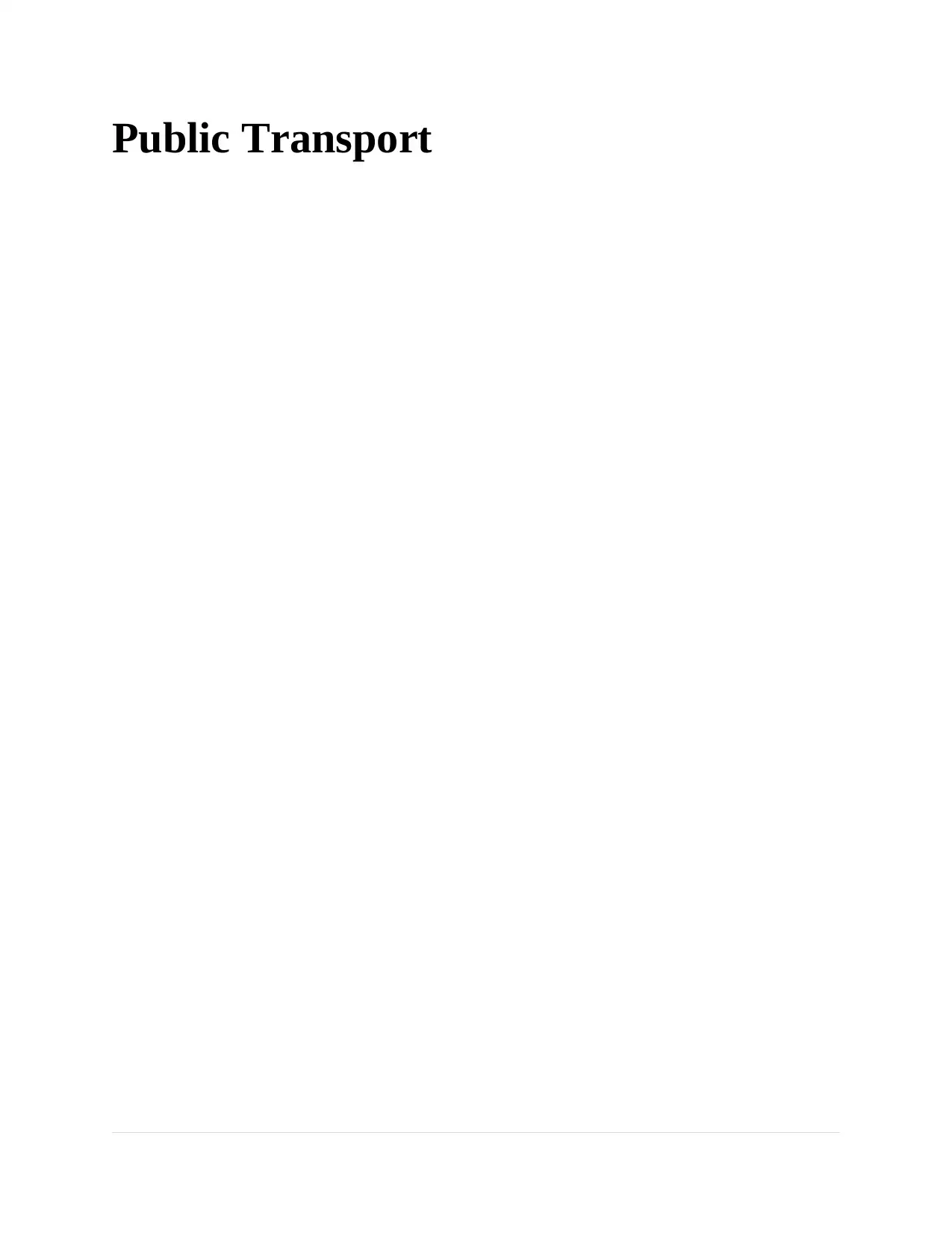
Public Transport
Paraphrase This Document
Need a fresh take? Get an instant paraphrase of this document with our AI Paraphraser
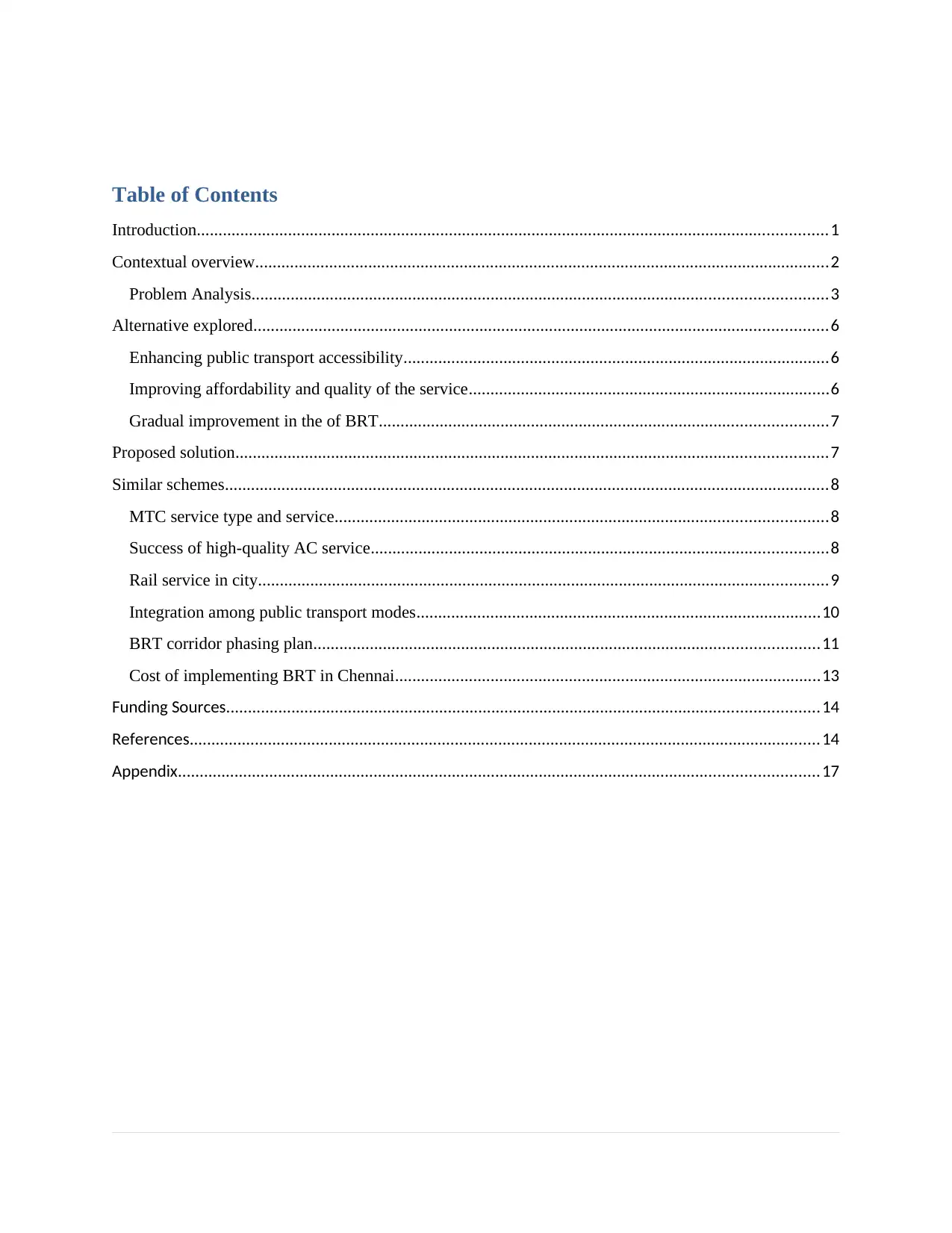
Table of Contents
Introduction.................................................................................................................................................1
Contextual overview....................................................................................................................................2
Problem Analysis....................................................................................................................................3
Alternative explored....................................................................................................................................6
Enhancing public transport accessibility..................................................................................................6
Improving affordability and quality of the service...................................................................................6
Gradual improvement in the of BRT.......................................................................................................7
Proposed solution........................................................................................................................................7
Similar schemes...........................................................................................................................................8
MTC service type and service.................................................................................................................8
Success of high-quality AC service.........................................................................................................8
Rail service in city...................................................................................................................................9
Integration among public transport modes.............................................................................................10
BRT corridor phasing plan....................................................................................................................11
Cost of implementing BRT in Chennai..................................................................................................13
Funding Sources........................................................................................................................................14
References.................................................................................................................................................14
Appendix...................................................................................................................................................17
Introduction.................................................................................................................................................1
Contextual overview....................................................................................................................................2
Problem Analysis....................................................................................................................................3
Alternative explored....................................................................................................................................6
Enhancing public transport accessibility..................................................................................................6
Improving affordability and quality of the service...................................................................................6
Gradual improvement in the of BRT.......................................................................................................7
Proposed solution........................................................................................................................................7
Similar schemes...........................................................................................................................................8
MTC service type and service.................................................................................................................8
Success of high-quality AC service.........................................................................................................8
Rail service in city...................................................................................................................................9
Integration among public transport modes.............................................................................................10
BRT corridor phasing plan....................................................................................................................11
Cost of implementing BRT in Chennai..................................................................................................13
Funding Sources........................................................................................................................................14
References.................................................................................................................................................14
Appendix...................................................................................................................................................17
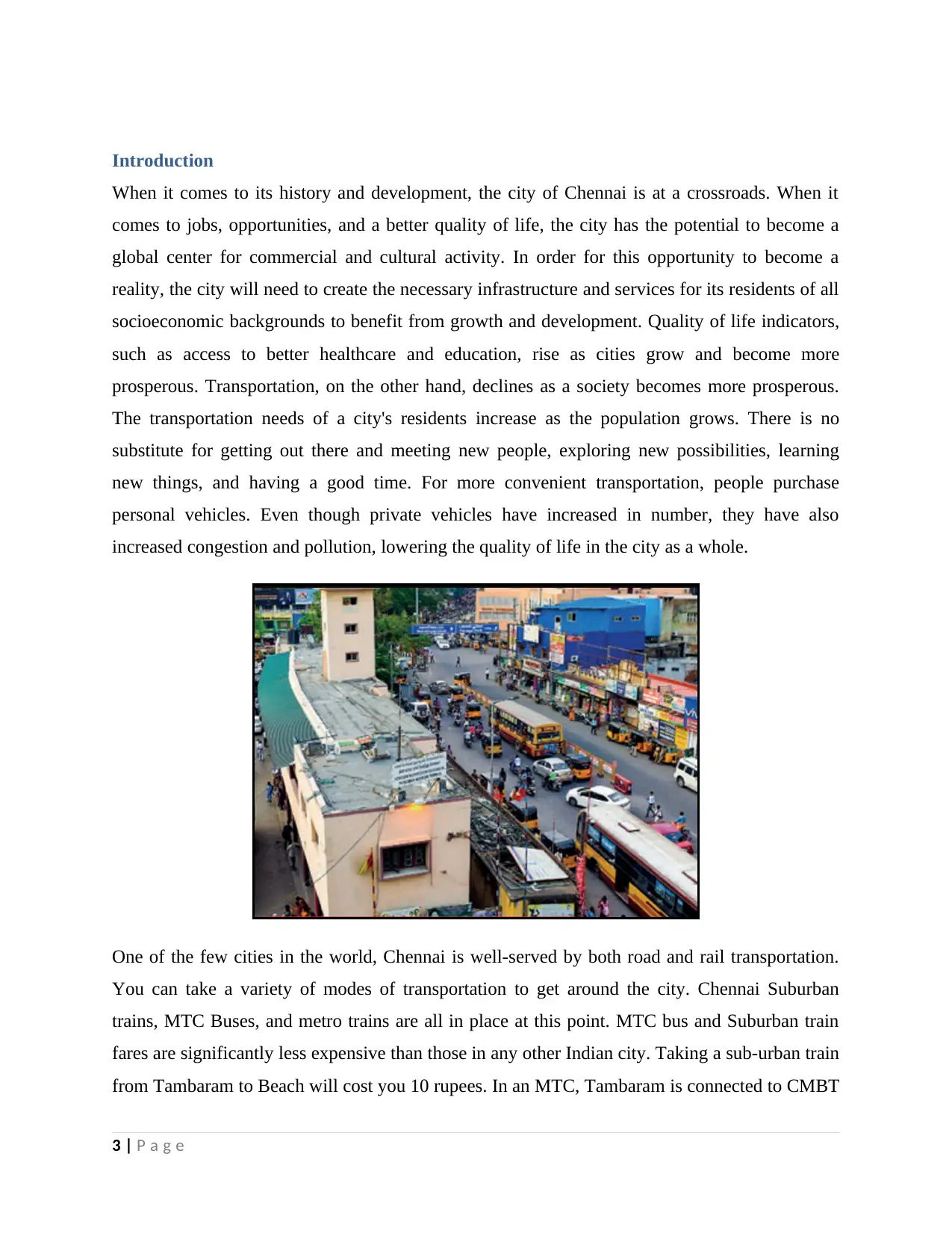
Introduction
When it comes to its history and development, the city of Chennai is at a crossroads. When it
comes to jobs, opportunities, and a better quality of life, the city has the potential to become a
global center for commercial and cultural activity. In order for this opportunity to become a
reality, the city will need to create the necessary infrastructure and services for its residents of all
socioeconomic backgrounds to benefit from growth and development. Quality of life indicators,
such as access to better healthcare and education, rise as cities grow and become more
prosperous. Transportation, on the other hand, declines as a society becomes more prosperous.
The transportation needs of a city's residents increase as the population grows. There is no
substitute for getting out there and meeting new people, exploring new possibilities, learning
new things, and having a good time. For more convenient transportation, people purchase
personal vehicles. Even though private vehicles have increased in number, they have also
increased congestion and pollution, lowering the quality of life in the city as a whole.
One of the few cities in the world, Chennai is well-served by both road and rail transportation.
You can take a variety of modes of transportation to get around the city. Chennai Suburban
trains, MTC Buses, and metro trains are all in place at this point. MTC bus and Suburban train
fares are significantly less expensive than those in any other Indian city. Taking a sub-urban train
from Tambaram to Beach will cost you 10 rupees. In an MTC, Tambaram is connected to CMBT
3 | P a g e
When it comes to its history and development, the city of Chennai is at a crossroads. When it
comes to jobs, opportunities, and a better quality of life, the city has the potential to become a
global center for commercial and cultural activity. In order for this opportunity to become a
reality, the city will need to create the necessary infrastructure and services for its residents of all
socioeconomic backgrounds to benefit from growth and development. Quality of life indicators,
such as access to better healthcare and education, rise as cities grow and become more
prosperous. Transportation, on the other hand, declines as a society becomes more prosperous.
The transportation needs of a city's residents increase as the population grows. There is no
substitute for getting out there and meeting new people, exploring new possibilities, learning
new things, and having a good time. For more convenient transportation, people purchase
personal vehicles. Even though private vehicles have increased in number, they have also
increased congestion and pollution, lowering the quality of life in the city as a whole.
One of the few cities in the world, Chennai is well-served by both road and rail transportation.
You can take a variety of modes of transportation to get around the city. Chennai Suburban
trains, MTC Buses, and metro trains are all in place at this point. MTC bus and Suburban train
fares are significantly less expensive than those in any other Indian city. Taking a sub-urban train
from Tambaram to Beach will cost you 10 rupees. In an MTC, Tambaram is connected to CMBT
3 | P a g e
⊘ This is a preview!⊘
Do you want full access?
Subscribe today to unlock all pages.

Trusted by 1+ million students worldwide
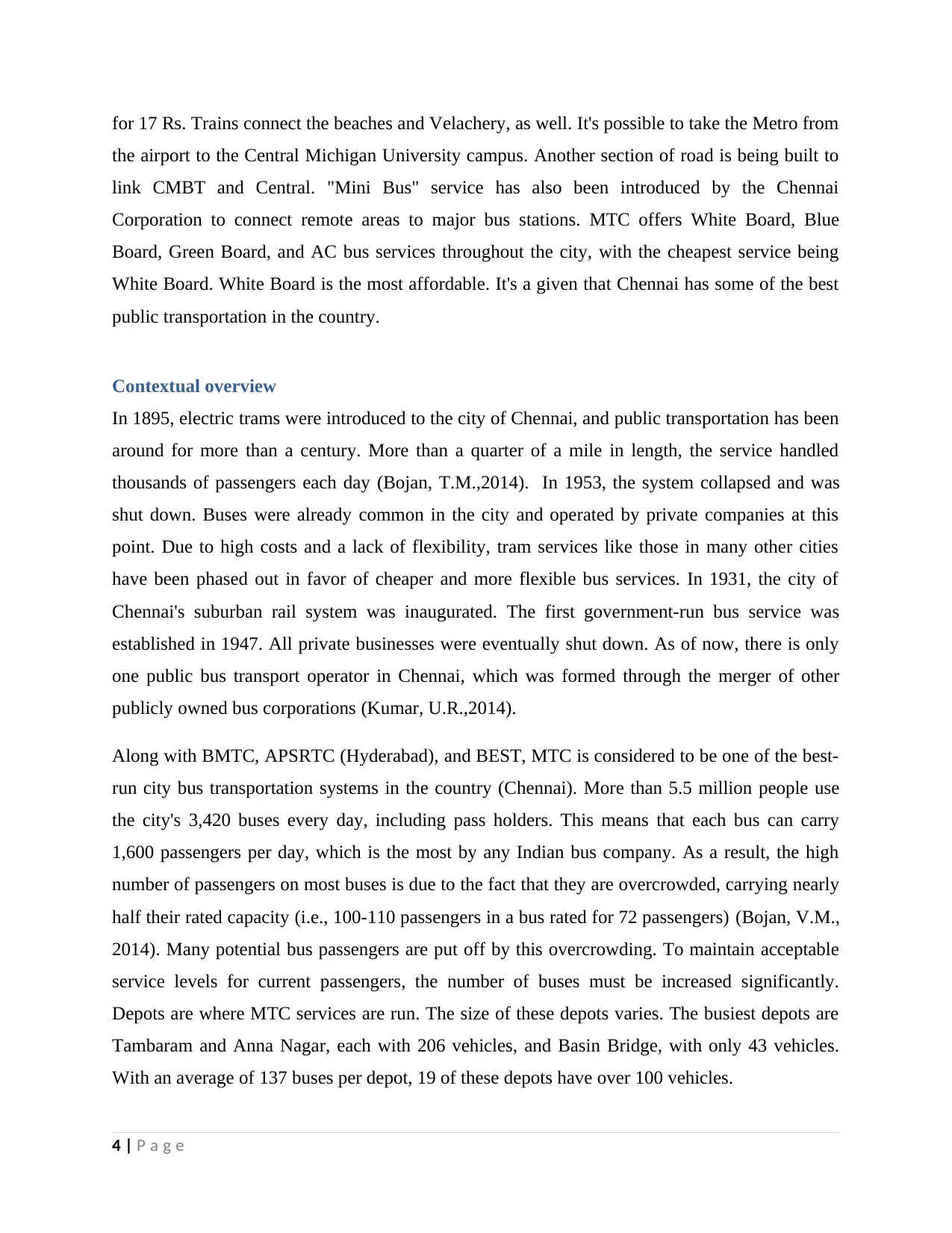
for 17 Rs. Trains connect the beaches and Velachery, as well. It's possible to take the Metro from
the airport to the Central Michigan University campus. Another section of road is being built to
link CMBT and Central. "Mini Bus" service has also been introduced by the Chennai
Corporation to connect remote areas to major bus stations. MTC offers White Board, Blue
Board, Green Board, and AC bus services throughout the city, with the cheapest service being
White Board. White Board is the most affordable. It's a given that Chennai has some of the best
public transportation in the country.
Contextual overview
In 1895, electric trams were introduced to the city of Chennai, and public transportation has been
around for more than a century. More than a quarter of a mile in length, the service handled
thousands of passengers each day (Bojan, T.M.,2014). In 1953, the system collapsed and was
shut down. Buses were already common in the city and operated by private companies at this
point. Due to high costs and a lack of flexibility, tram services like those in many other cities
have been phased out in favor of cheaper and more flexible bus services. In 1931, the city of
Chennai's suburban rail system was inaugurated. The first government-run bus service was
established in 1947. All private businesses were eventually shut down. As of now, there is only
one public bus transport operator in Chennai, which was formed through the merger of other
publicly owned bus corporations (Kumar, U.R.,2014).
Along with BMTC, APSRTC (Hyderabad), and BEST, MTC is considered to be one of the best-
run city bus transportation systems in the country (Chennai). More than 5.5 million people use
the city's 3,420 buses every day, including pass holders. This means that each bus can carry
1,600 passengers per day, which is the most by any Indian bus company. As a result, the high
number of passengers on most buses is due to the fact that they are overcrowded, carrying nearly
half their rated capacity (i.e., 100-110 passengers in a bus rated for 72 passengers) (Bojan, V.M.,
2014). Many potential bus passengers are put off by this overcrowding. To maintain acceptable
service levels for current passengers, the number of buses must be increased significantly.
Depots are where MTC services are run. The size of these depots varies. The busiest depots are
Tambaram and Anna Nagar, each with 206 vehicles, and Basin Bridge, with only 43 vehicles.
With an average of 137 buses per depot, 19 of these depots have over 100 vehicles.
4 | P a g e
the airport to the Central Michigan University campus. Another section of road is being built to
link CMBT and Central. "Mini Bus" service has also been introduced by the Chennai
Corporation to connect remote areas to major bus stations. MTC offers White Board, Blue
Board, Green Board, and AC bus services throughout the city, with the cheapest service being
White Board. White Board is the most affordable. It's a given that Chennai has some of the best
public transportation in the country.
Contextual overview
In 1895, electric trams were introduced to the city of Chennai, and public transportation has been
around for more than a century. More than a quarter of a mile in length, the service handled
thousands of passengers each day (Bojan, T.M.,2014). In 1953, the system collapsed and was
shut down. Buses were already common in the city and operated by private companies at this
point. Due to high costs and a lack of flexibility, tram services like those in many other cities
have been phased out in favor of cheaper and more flexible bus services. In 1931, the city of
Chennai's suburban rail system was inaugurated. The first government-run bus service was
established in 1947. All private businesses were eventually shut down. As of now, there is only
one public bus transport operator in Chennai, which was formed through the merger of other
publicly owned bus corporations (Kumar, U.R.,2014).
Along with BMTC, APSRTC (Hyderabad), and BEST, MTC is considered to be one of the best-
run city bus transportation systems in the country (Chennai). More than 5.5 million people use
the city's 3,420 buses every day, including pass holders. This means that each bus can carry
1,600 passengers per day, which is the most by any Indian bus company. As a result, the high
number of passengers on most buses is due to the fact that they are overcrowded, carrying nearly
half their rated capacity (i.e., 100-110 passengers in a bus rated for 72 passengers) (Bojan, V.M.,
2014). Many potential bus passengers are put off by this overcrowding. To maintain acceptable
service levels for current passengers, the number of buses must be increased significantly.
Depots are where MTC services are run. The size of these depots varies. The busiest depots are
Tambaram and Anna Nagar, each with 206 vehicles, and Basin Bridge, with only 43 vehicles.
With an average of 137 buses per depot, 19 of these depots have over 100 vehicles.
4 | P a g e
Paraphrase This Document
Need a fresh take? Get an instant paraphrase of this document with our AI Paraphraser
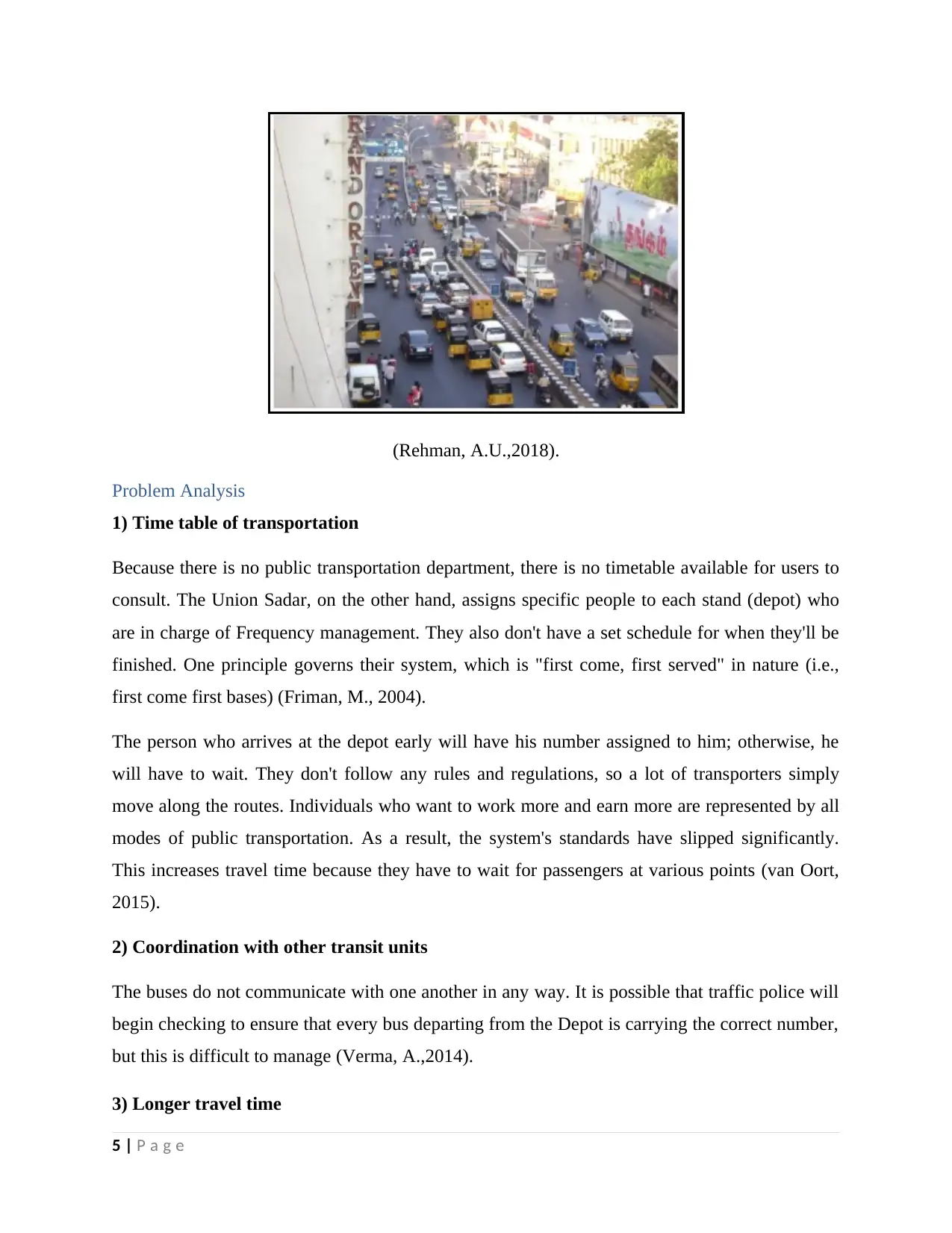
(Rehman, A.U.,2018).
Problem Analysis
1) Time table of transportation
Because there is no public transportation department, there is no timetable available for users to
consult. The Union Sadar, on the other hand, assigns specific people to each stand (depot) who
are in charge of Frequency management. They also don't have a set schedule for when they'll be
finished. One principle governs their system, which is "first come, first served" in nature (i.e.,
first come first bases) (Friman, M., 2004).
The person who arrives at the depot early will have his number assigned to him; otherwise, he
will have to wait. They don't follow any rules and regulations, so a lot of transporters simply
move along the routes. Individuals who want to work more and earn more are represented by all
modes of public transportation. As a result, the system's standards have slipped significantly.
This increases travel time because they have to wait for passengers at various points (van Oort,
2015).
2) Coordination with other transit units
The buses do not communicate with one another in any way. It is possible that traffic police will
begin checking to ensure that every bus departing from the Depot is carrying the correct number,
but this is difficult to manage (Verma, A.,2014).
3) Longer travel time
5 | P a g e
Problem Analysis
1) Time table of transportation
Because there is no public transportation department, there is no timetable available for users to
consult. The Union Sadar, on the other hand, assigns specific people to each stand (depot) who
are in charge of Frequency management. They also don't have a set schedule for when they'll be
finished. One principle governs their system, which is "first come, first served" in nature (i.e.,
first come first bases) (Friman, M., 2004).
The person who arrives at the depot early will have his number assigned to him; otherwise, he
will have to wait. They don't follow any rules and regulations, so a lot of transporters simply
move along the routes. Individuals who want to work more and earn more are represented by all
modes of public transportation. As a result, the system's standards have slipped significantly.
This increases travel time because they have to wait for passengers at various points (van Oort,
2015).
2) Coordination with other transit units
The buses do not communicate with one another in any way. It is possible that traffic police will
begin checking to ensure that every bus departing from the Depot is carrying the correct number,
but this is difficult to manage (Verma, A.,2014).
3) Longer travel time
5 | P a g e
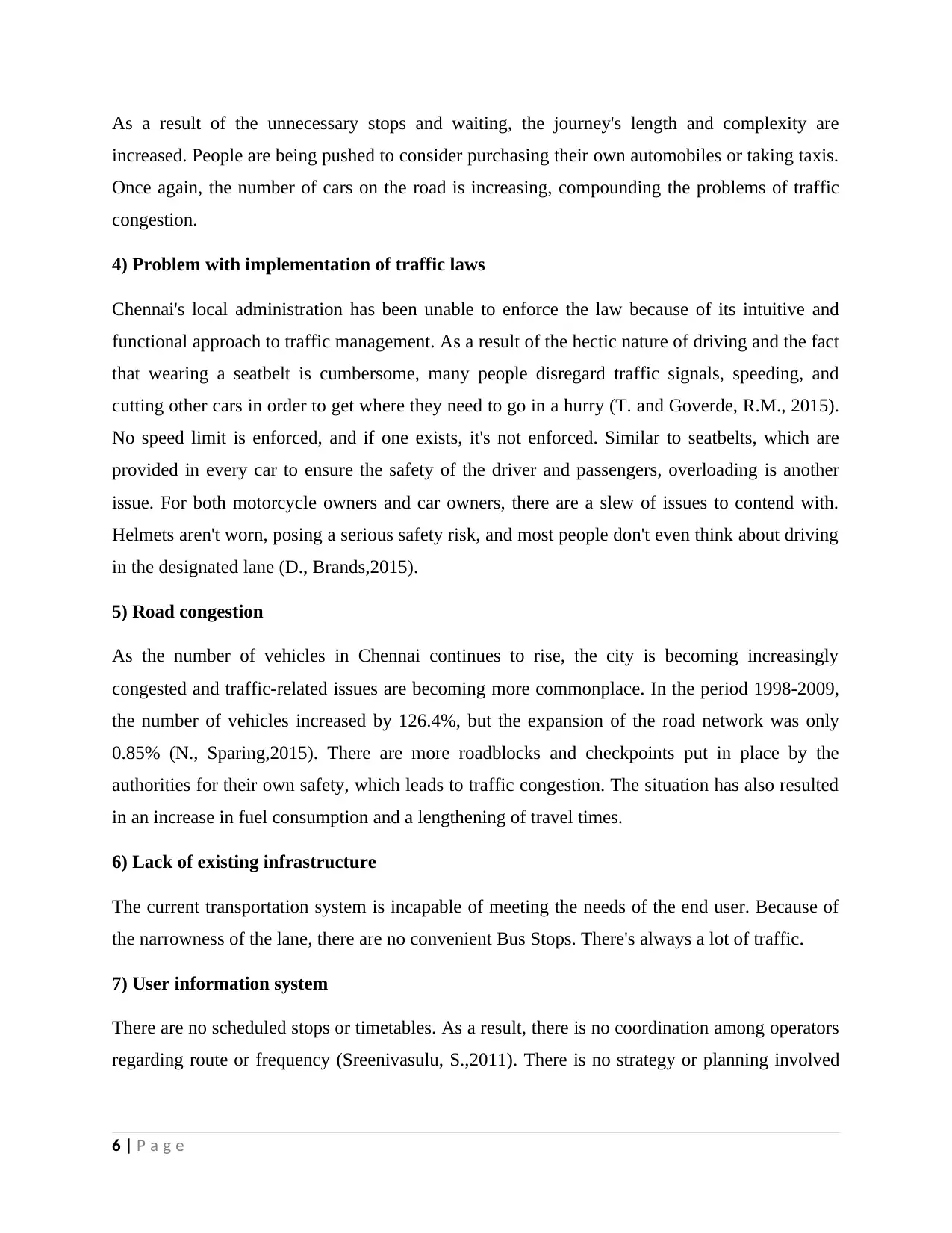
As a result of the unnecessary stops and waiting, the journey's length and complexity are
increased. People are being pushed to consider purchasing their own automobiles or taking taxis.
Once again, the number of cars on the road is increasing, compounding the problems of traffic
congestion.
4) Problem with implementation of traffic laws
Chennai's local administration has been unable to enforce the law because of its intuitive and
functional approach to traffic management. As a result of the hectic nature of driving and the fact
that wearing a seatbelt is cumbersome, many people disregard traffic signals, speeding, and
cutting other cars in order to get where they need to go in a hurry (T. and Goverde, R.M., 2015).
No speed limit is enforced, and if one exists, it's not enforced. Similar to seatbelts, which are
provided in every car to ensure the safety of the driver and passengers, overloading is another
issue. For both motorcycle owners and car owners, there are a slew of issues to contend with.
Helmets aren't worn, posing a serious safety risk, and most people don't even think about driving
in the designated lane (D., Brands,2015).
5) Road congestion
As the number of vehicles in Chennai continues to rise, the city is becoming increasingly
congested and traffic-related issues are becoming more commonplace. In the period 1998-2009,
the number of vehicles increased by 126.4%, but the expansion of the road network was only
0.85% (N., Sparing,2015). There are more roadblocks and checkpoints put in place by the
authorities for their own safety, which leads to traffic congestion. The situation has also resulted
in an increase in fuel consumption and a lengthening of travel times.
6) Lack of existing infrastructure
The current transportation system is incapable of meeting the needs of the end user. Because of
the narrowness of the lane, there are no convenient Bus Stops. There's always a lot of traffic.
7) User information system
There are no scheduled stops or timetables. As a result, there is no coordination among operators
regarding route or frequency (Sreenivasulu, S.,2011). There is no strategy or planning involved
6 | P a g e
increased. People are being pushed to consider purchasing their own automobiles or taking taxis.
Once again, the number of cars on the road is increasing, compounding the problems of traffic
congestion.
4) Problem with implementation of traffic laws
Chennai's local administration has been unable to enforce the law because of its intuitive and
functional approach to traffic management. As a result of the hectic nature of driving and the fact
that wearing a seatbelt is cumbersome, many people disregard traffic signals, speeding, and
cutting other cars in order to get where they need to go in a hurry (T. and Goverde, R.M., 2015).
No speed limit is enforced, and if one exists, it's not enforced. Similar to seatbelts, which are
provided in every car to ensure the safety of the driver and passengers, overloading is another
issue. For both motorcycle owners and car owners, there are a slew of issues to contend with.
Helmets aren't worn, posing a serious safety risk, and most people don't even think about driving
in the designated lane (D., Brands,2015).
5) Road congestion
As the number of vehicles in Chennai continues to rise, the city is becoming increasingly
congested and traffic-related issues are becoming more commonplace. In the period 1998-2009,
the number of vehicles increased by 126.4%, but the expansion of the road network was only
0.85% (N., Sparing,2015). There are more roadblocks and checkpoints put in place by the
authorities for their own safety, which leads to traffic congestion. The situation has also resulted
in an increase in fuel consumption and a lengthening of travel times.
6) Lack of existing infrastructure
The current transportation system is incapable of meeting the needs of the end user. Because of
the narrowness of the lane, there are no convenient Bus Stops. There's always a lot of traffic.
7) User information system
There are no scheduled stops or timetables. As a result, there is no coordination among operators
regarding route or frequency (Sreenivasulu, S.,2011). There is no strategy or planning involved
6 | P a g e
⊘ This is a preview!⊘
Do you want full access?
Subscribe today to unlock all pages.

Trusted by 1+ million students worldwide
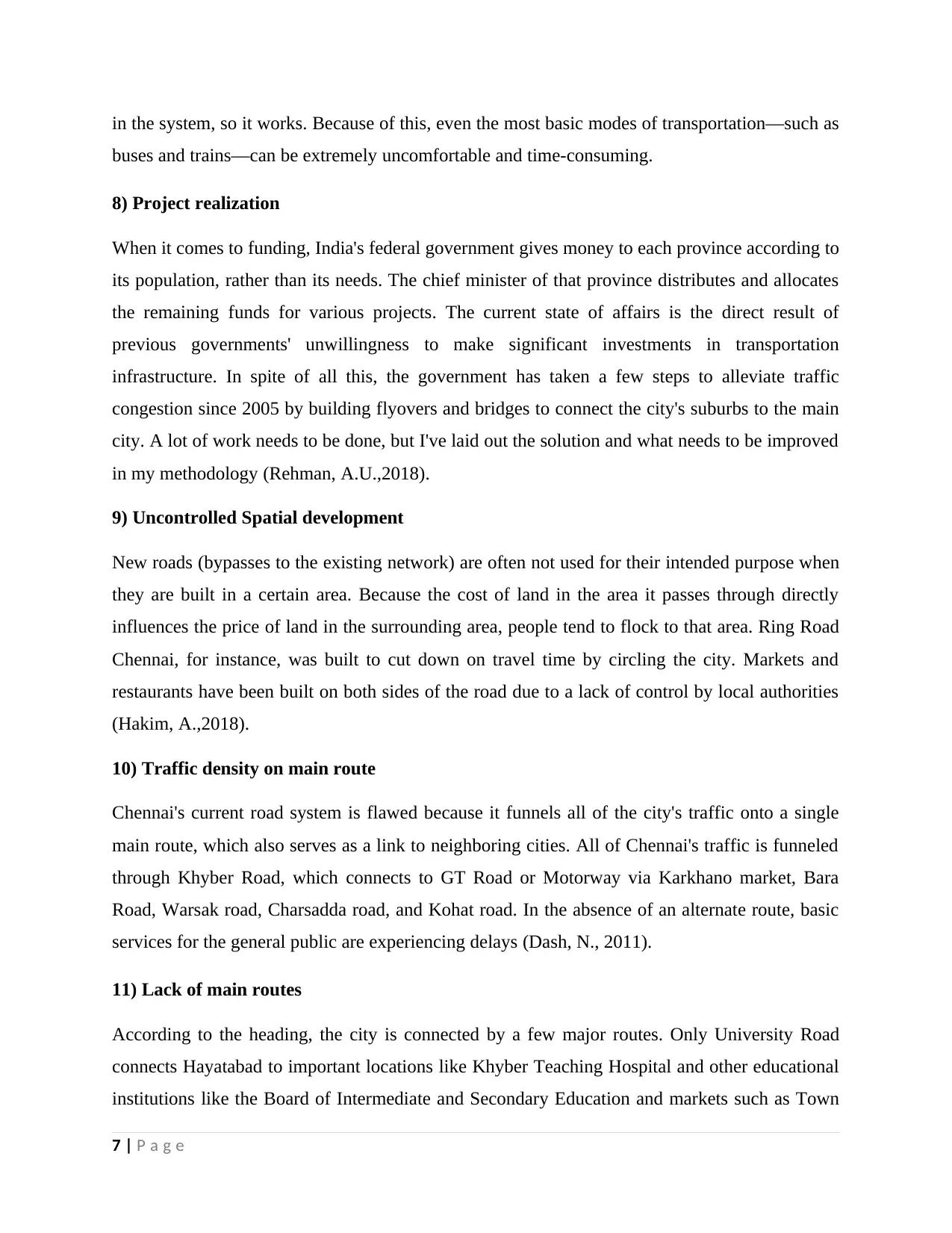
in the system, so it works. Because of this, even the most basic modes of transportation—such as
buses and trains—can be extremely uncomfortable and time-consuming.
8) Project realization
When it comes to funding, India's federal government gives money to each province according to
its population, rather than its needs. The chief minister of that province distributes and allocates
the remaining funds for various projects. The current state of affairs is the direct result of
previous governments' unwillingness to make significant investments in transportation
infrastructure. In spite of all this, the government has taken a few steps to alleviate traffic
congestion since 2005 by building flyovers and bridges to connect the city's suburbs to the main
city. A lot of work needs to be done, but I've laid out the solution and what needs to be improved
in my methodology (Rehman, A.U.,2018).
9) Uncontrolled Spatial development
New roads (bypasses to the existing network) are often not used for their intended purpose when
they are built in a certain area. Because the cost of land in the area it passes through directly
influences the price of land in the surrounding area, people tend to flock to that area. Ring Road
Chennai, for instance, was built to cut down on travel time by circling the city. Markets and
restaurants have been built on both sides of the road due to a lack of control by local authorities
(Hakim, A.,2018).
10) Traffic density on main route
Chennai's current road system is flawed because it funnels all of the city's traffic onto a single
main route, which also serves as a link to neighboring cities. All of Chennai's traffic is funneled
through Khyber Road, which connects to GT Road or Motorway via Karkhano market, Bara
Road, Warsak road, Charsadda road, and Kohat road. In the absence of an alternate route, basic
services for the general public are experiencing delays (Dash, N., 2011).
11) Lack of main routes
According to the heading, the city is connected by a few major routes. Only University Road
connects Hayatabad to important locations like Khyber Teaching Hospital and other educational
institutions like the Board of Intermediate and Secondary Education and markets such as Town
7 | P a g e
buses and trains—can be extremely uncomfortable and time-consuming.
8) Project realization
When it comes to funding, India's federal government gives money to each province according to
its population, rather than its needs. The chief minister of that province distributes and allocates
the remaining funds for various projects. The current state of affairs is the direct result of
previous governments' unwillingness to make significant investments in transportation
infrastructure. In spite of all this, the government has taken a few steps to alleviate traffic
congestion since 2005 by building flyovers and bridges to connect the city's suburbs to the main
city. A lot of work needs to be done, but I've laid out the solution and what needs to be improved
in my methodology (Rehman, A.U.,2018).
9) Uncontrolled Spatial development
New roads (bypasses to the existing network) are often not used for their intended purpose when
they are built in a certain area. Because the cost of land in the area it passes through directly
influences the price of land in the surrounding area, people tend to flock to that area. Ring Road
Chennai, for instance, was built to cut down on travel time by circling the city. Markets and
restaurants have been built on both sides of the road due to a lack of control by local authorities
(Hakim, A.,2018).
10) Traffic density on main route
Chennai's current road system is flawed because it funnels all of the city's traffic onto a single
main route, which also serves as a link to neighboring cities. All of Chennai's traffic is funneled
through Khyber Road, which connects to GT Road or Motorway via Karkhano market, Bara
Road, Warsak road, Charsadda road, and Kohat road. In the absence of an alternate route, basic
services for the general public are experiencing delays (Dash, N., 2011).
11) Lack of main routes
According to the heading, the city is connected by a few major routes. Only University Road
connects Hayatabad to important locations like Khyber Teaching Hospital and other educational
institutions like the Board of Intermediate and Secondary Education and markets such as Town
7 | P a g e
Paraphrase This Document
Need a fresh take? Get an instant paraphrase of this document with our AI Paraphraser
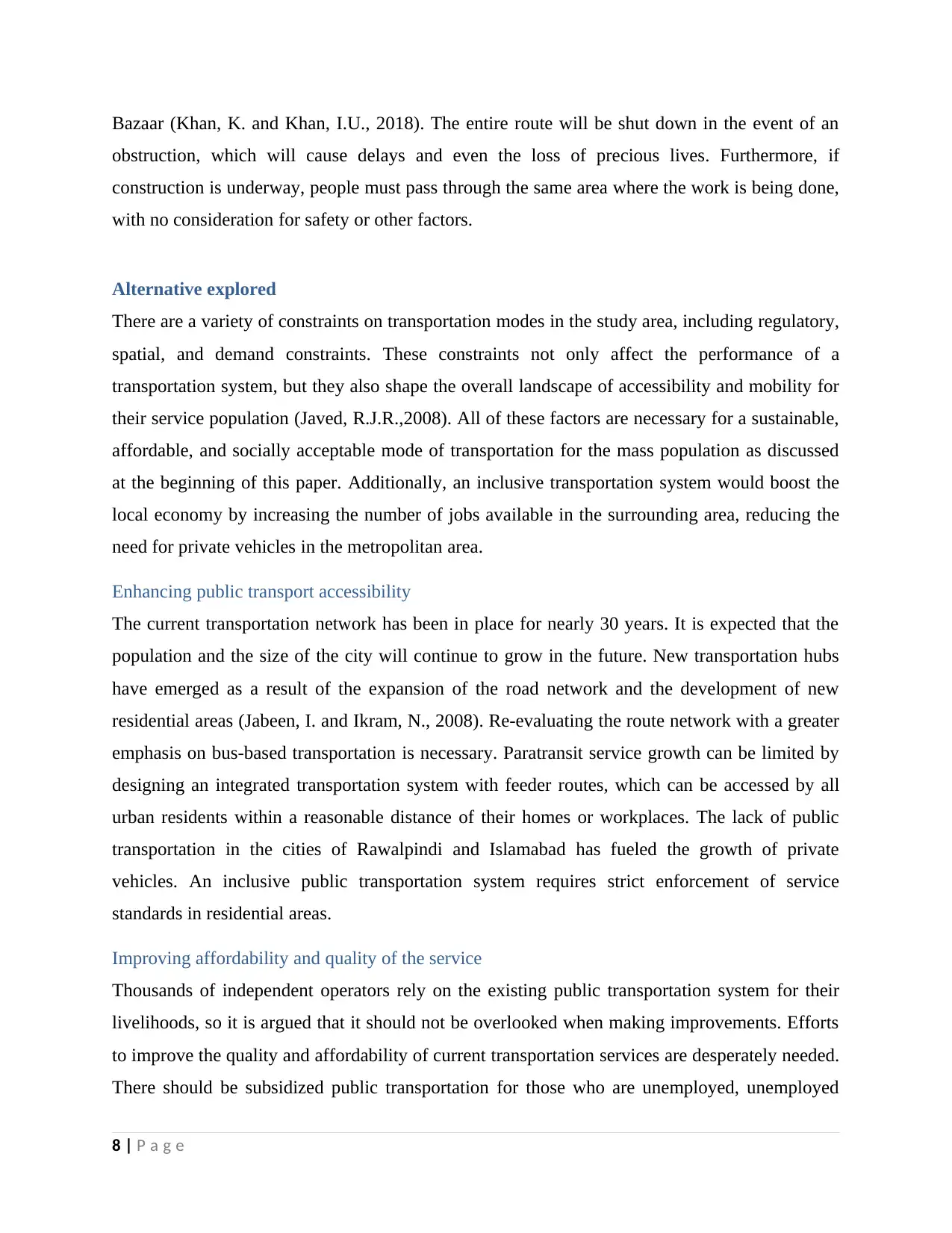
Bazaar (Khan, K. and Khan, I.U., 2018). The entire route will be shut down in the event of an
obstruction, which will cause delays and even the loss of precious lives. Furthermore, if
construction is underway, people must pass through the same area where the work is being done,
with no consideration for safety or other factors.
Alternative explored
There are a variety of constraints on transportation modes in the study area, including regulatory,
spatial, and demand constraints. These constraints not only affect the performance of a
transportation system, but they also shape the overall landscape of accessibility and mobility for
their service population (Javed, R.J.R.,2008). All of these factors are necessary for a sustainable,
affordable, and socially acceptable mode of transportation for the mass population as discussed
at the beginning of this paper. Additionally, an inclusive transportation system would boost the
local economy by increasing the number of jobs available in the surrounding area, reducing the
need for private vehicles in the metropolitan area.
Enhancing public transport accessibility
The current transportation network has been in place for nearly 30 years. It is expected that the
population and the size of the city will continue to grow in the future. New transportation hubs
have emerged as a result of the expansion of the road network and the development of new
residential areas (Jabeen, I. and Ikram, N., 2008). Re-evaluating the route network with a greater
emphasis on bus-based transportation is necessary. Paratransit service growth can be limited by
designing an integrated transportation system with feeder routes, which can be accessed by all
urban residents within a reasonable distance of their homes or workplaces. The lack of public
transportation in the cities of Rawalpindi and Islamabad has fueled the growth of private
vehicles. An inclusive public transportation system requires strict enforcement of service
standards in residential areas.
Improving affordability and quality of the service
Thousands of independent operators rely on the existing public transportation system for their
livelihoods, so it is argued that it should not be overlooked when making improvements. Efforts
to improve the quality and affordability of current transportation services are desperately needed.
There should be subsidized public transportation for those who are unemployed, unemployed
8 | P a g e
obstruction, which will cause delays and even the loss of precious lives. Furthermore, if
construction is underway, people must pass through the same area where the work is being done,
with no consideration for safety or other factors.
Alternative explored
There are a variety of constraints on transportation modes in the study area, including regulatory,
spatial, and demand constraints. These constraints not only affect the performance of a
transportation system, but they also shape the overall landscape of accessibility and mobility for
their service population (Javed, R.J.R.,2008). All of these factors are necessary for a sustainable,
affordable, and socially acceptable mode of transportation for the mass population as discussed
at the beginning of this paper. Additionally, an inclusive transportation system would boost the
local economy by increasing the number of jobs available in the surrounding area, reducing the
need for private vehicles in the metropolitan area.
Enhancing public transport accessibility
The current transportation network has been in place for nearly 30 years. It is expected that the
population and the size of the city will continue to grow in the future. New transportation hubs
have emerged as a result of the expansion of the road network and the development of new
residential areas (Jabeen, I. and Ikram, N., 2008). Re-evaluating the route network with a greater
emphasis on bus-based transportation is necessary. Paratransit service growth can be limited by
designing an integrated transportation system with feeder routes, which can be accessed by all
urban residents within a reasonable distance of their homes or workplaces. The lack of public
transportation in the cities of Rawalpindi and Islamabad has fueled the growth of private
vehicles. An inclusive public transportation system requires strict enforcement of service
standards in residential areas.
Improving affordability and quality of the service
Thousands of independent operators rely on the existing public transportation system for their
livelihoods, so it is argued that it should not be overlooked when making improvements. Efforts
to improve the quality and affordability of current transportation services are desperately needed.
There should be subsidized public transportation for those who are unemployed, unemployed
8 | P a g e
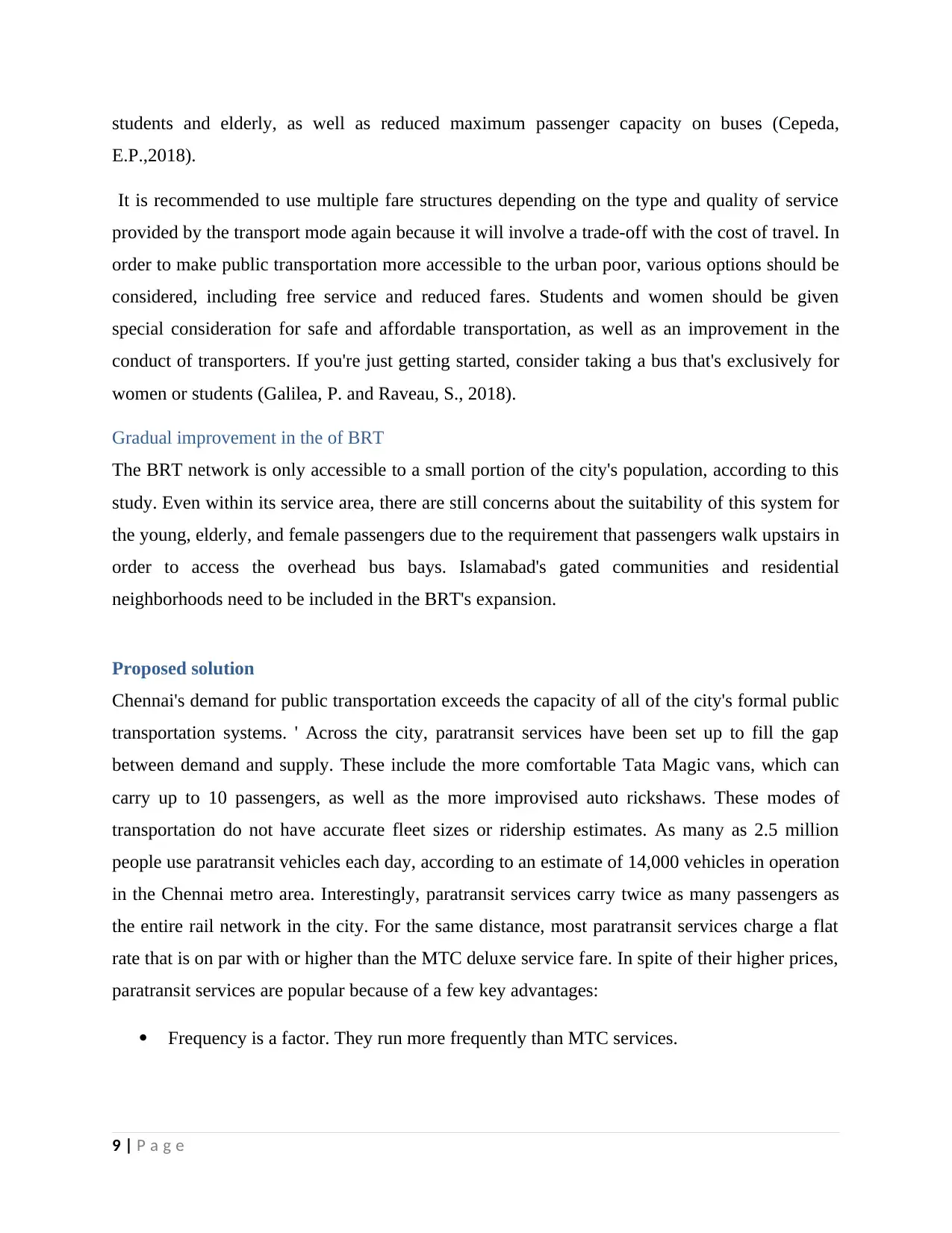
students and elderly, as well as reduced maximum passenger capacity on buses (Cepeda,
E.P.,2018).
It is recommended to use multiple fare structures depending on the type and quality of service
provided by the transport mode again because it will involve a trade-off with the cost of travel. In
order to make public transportation more accessible to the urban poor, various options should be
considered, including free service and reduced fares. Students and women should be given
special consideration for safe and affordable transportation, as well as an improvement in the
conduct of transporters. If you're just getting started, consider taking a bus that's exclusively for
women or students (Galilea, P. and Raveau, S., 2018).
Gradual improvement in the of BRT
The BRT network is only accessible to a small portion of the city's population, according to this
study. Even within its service area, there are still concerns about the suitability of this system for
the young, elderly, and female passengers due to the requirement that passengers walk upstairs in
order to access the overhead bus bays. Islamabad's gated communities and residential
neighborhoods need to be included in the BRT's expansion.
Proposed solution
Chennai's demand for public transportation exceeds the capacity of all of the city's formal public
transportation systems. ' Across the city, paratransit services have been set up to fill the gap
between demand and supply. These include the more comfortable Tata Magic vans, which can
carry up to 10 passengers, as well as the more improvised auto rickshaws. These modes of
transportation do not have accurate fleet sizes or ridership estimates. As many as 2.5 million
people use paratransit vehicles each day, according to an estimate of 14,000 vehicles in operation
in the Chennai metro area. Interestingly, paratransit services carry twice as many passengers as
the entire rail network in the city. For the same distance, most paratransit services charge a flat
rate that is on par with or higher than the MTC deluxe service fare. In spite of their higher prices,
paratransit services are popular because of a few key advantages:
Frequency is a factor. They run more frequently than MTC services.
9 | P a g e
E.P.,2018).
It is recommended to use multiple fare structures depending on the type and quality of service
provided by the transport mode again because it will involve a trade-off with the cost of travel. In
order to make public transportation more accessible to the urban poor, various options should be
considered, including free service and reduced fares. Students and women should be given
special consideration for safe and affordable transportation, as well as an improvement in the
conduct of transporters. If you're just getting started, consider taking a bus that's exclusively for
women or students (Galilea, P. and Raveau, S., 2018).
Gradual improvement in the of BRT
The BRT network is only accessible to a small portion of the city's population, according to this
study. Even within its service area, there are still concerns about the suitability of this system for
the young, elderly, and female passengers due to the requirement that passengers walk upstairs in
order to access the overhead bus bays. Islamabad's gated communities and residential
neighborhoods need to be included in the BRT's expansion.
Proposed solution
Chennai's demand for public transportation exceeds the capacity of all of the city's formal public
transportation systems. ' Across the city, paratransit services have been set up to fill the gap
between demand and supply. These include the more comfortable Tata Magic vans, which can
carry up to 10 passengers, as well as the more improvised auto rickshaws. These modes of
transportation do not have accurate fleet sizes or ridership estimates. As many as 2.5 million
people use paratransit vehicles each day, according to an estimate of 14,000 vehicles in operation
in the Chennai metro area. Interestingly, paratransit services carry twice as many passengers as
the entire rail network in the city. For the same distance, most paratransit services charge a flat
rate that is on par with or higher than the MTC deluxe service fare. In spite of their higher prices,
paratransit services are popular because of a few key advantages:
Frequency is a factor. They run more frequently than MTC services.
9 | P a g e
⊘ This is a preview!⊘
Do you want full access?
Subscribe today to unlock all pages.

Trusted by 1+ million students worldwide
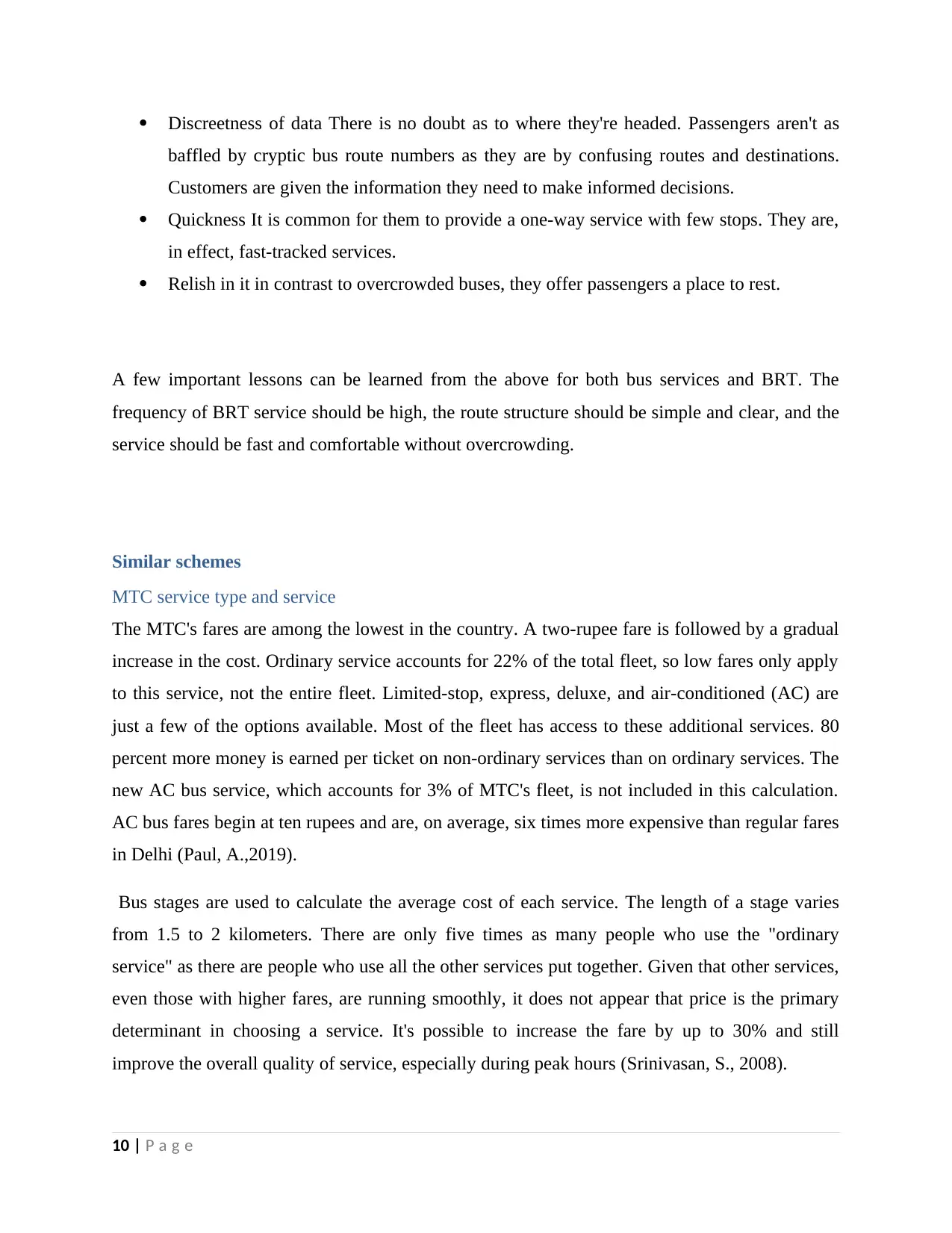
Discreetness of data There is no doubt as to where they're headed. Passengers aren't as
baffled by cryptic bus route numbers as they are by confusing routes and destinations.
Customers are given the information they need to make informed decisions.
Quickness It is common for them to provide a one-way service with few stops. They are,
in effect, fast-tracked services.
Relish in it in contrast to overcrowded buses, they offer passengers a place to rest.
A few important lessons can be learned from the above for both bus services and BRT. The
frequency of BRT service should be high, the route structure should be simple and clear, and the
service should be fast and comfortable without overcrowding.
Similar schemes
MTC service type and service
The MTC's fares are among the lowest in the country. A two-rupee fare is followed by a gradual
increase in the cost. Ordinary service accounts for 22% of the total fleet, so low fares only apply
to this service, not the entire fleet. Limited-stop, express, deluxe, and air-conditioned (AC) are
just a few of the options available. Most of the fleet has access to these additional services. 80
percent more money is earned per ticket on non-ordinary services than on ordinary services. The
new AC bus service, which accounts for 3% of MTC's fleet, is not included in this calculation.
AC bus fares begin at ten rupees and are, on average, six times more expensive than regular fares
in Delhi (Paul, A.,2019).
Bus stages are used to calculate the average cost of each service. The length of a stage varies
from 1.5 to 2 kilometers. There are only five times as many people who use the "ordinary
service" as there are people who use all the other services put together. Given that other services,
even those with higher fares, are running smoothly, it does not appear that price is the primary
determinant in choosing a service. It's possible to increase the fare by up to 30% and still
improve the overall quality of service, especially during peak hours (Srinivasan, S., 2008).
10 | P a g e
baffled by cryptic bus route numbers as they are by confusing routes and destinations.
Customers are given the information they need to make informed decisions.
Quickness It is common for them to provide a one-way service with few stops. They are,
in effect, fast-tracked services.
Relish in it in contrast to overcrowded buses, they offer passengers a place to rest.
A few important lessons can be learned from the above for both bus services and BRT. The
frequency of BRT service should be high, the route structure should be simple and clear, and the
service should be fast and comfortable without overcrowding.
Similar schemes
MTC service type and service
The MTC's fares are among the lowest in the country. A two-rupee fare is followed by a gradual
increase in the cost. Ordinary service accounts for 22% of the total fleet, so low fares only apply
to this service, not the entire fleet. Limited-stop, express, deluxe, and air-conditioned (AC) are
just a few of the options available. Most of the fleet has access to these additional services. 80
percent more money is earned per ticket on non-ordinary services than on ordinary services. The
new AC bus service, which accounts for 3% of MTC's fleet, is not included in this calculation.
AC bus fares begin at ten rupees and are, on average, six times more expensive than regular fares
in Delhi (Paul, A.,2019).
Bus stages are used to calculate the average cost of each service. The length of a stage varies
from 1.5 to 2 kilometers. There are only five times as many people who use the "ordinary
service" as there are people who use all the other services put together. Given that other services,
even those with higher fares, are running smoothly, it does not appear that price is the primary
determinant in choosing a service. It's possible to increase the fare by up to 30% and still
improve the overall quality of service, especially during peak hours (Srinivasan, S., 2008).
10 | P a g e
Paraphrase This Document
Need a fresh take? Get an instant paraphrase of this document with our AI Paraphraser
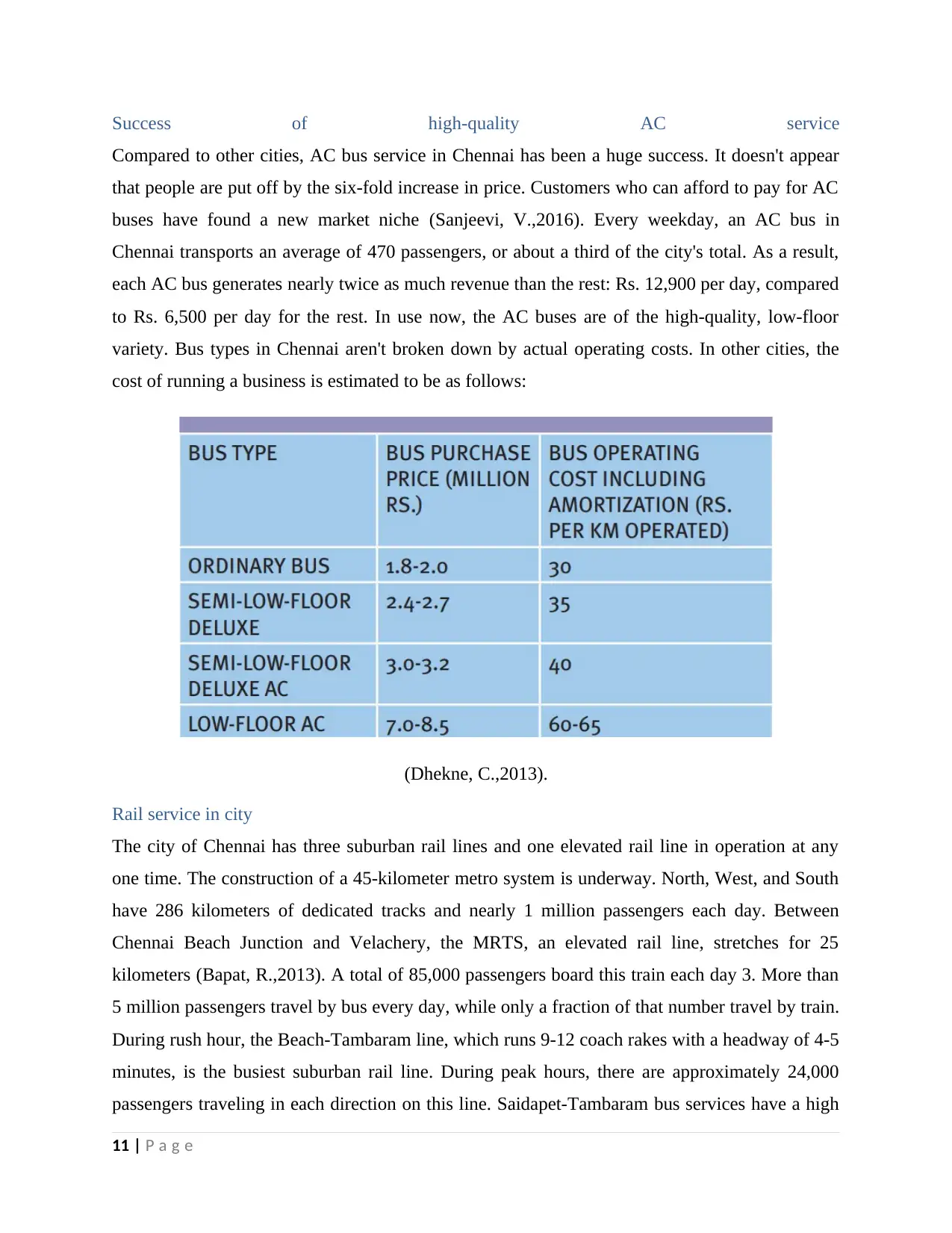
Success of high-quality AC service
Compared to other cities, AC bus service in Chennai has been a huge success. It doesn't appear
that people are put off by the six-fold increase in price. Customers who can afford to pay for AC
buses have found a new market niche (Sanjeevi, V.,2016). Every weekday, an AC bus in
Chennai transports an average of 470 passengers, or about a third of the city's total. As a result,
each AC bus generates nearly twice as much revenue than the rest: Rs. 12,900 per day, compared
to Rs. 6,500 per day for the rest. In use now, the AC buses are of the high-quality, low-floor
variety. Bus types in Chennai aren't broken down by actual operating costs. In other cities, the
cost of running a business is estimated to be as follows:
(Dhekne, C.,2013).
Rail service in city
The city of Chennai has three suburban rail lines and one elevated rail line in operation at any
one time. The construction of a 45-kilometer metro system is underway. North, West, and South
have 286 kilometers of dedicated tracks and nearly 1 million passengers each day. Between
Chennai Beach Junction and Velachery, the MRTS, an elevated rail line, stretches for 25
kilometers (Bapat, R.,2013). A total of 85,000 passengers board this train each day 3. More than
5 million passengers travel by bus every day, while only a fraction of that number travel by train.
During rush hour, the Beach-Tambaram line, which runs 9-12 coach rakes with a headway of 4-5
minutes, is the busiest suburban rail line. During peak hours, there are approximately 24,000
passengers traveling in each direction on this line. Saidapet-Tambaram bus services have a high
11 | P a g e
Compared to other cities, AC bus service in Chennai has been a huge success. It doesn't appear
that people are put off by the six-fold increase in price. Customers who can afford to pay for AC
buses have found a new market niche (Sanjeevi, V.,2016). Every weekday, an AC bus in
Chennai transports an average of 470 passengers, or about a third of the city's total. As a result,
each AC bus generates nearly twice as much revenue than the rest: Rs. 12,900 per day, compared
to Rs. 6,500 per day for the rest. In use now, the AC buses are of the high-quality, low-floor
variety. Bus types in Chennai aren't broken down by actual operating costs. In other cities, the
cost of running a business is estimated to be as follows:
(Dhekne, C.,2013).
Rail service in city
The city of Chennai has three suburban rail lines and one elevated rail line in operation at any
one time. The construction of a 45-kilometer metro system is underway. North, West, and South
have 286 kilometers of dedicated tracks and nearly 1 million passengers each day. Between
Chennai Beach Junction and Velachery, the MRTS, an elevated rail line, stretches for 25
kilometers (Bapat, R.,2013). A total of 85,000 passengers board this train each day 3. More than
5 million passengers travel by bus every day, while only a fraction of that number travel by train.
During rush hour, the Beach-Tambaram line, which runs 9-12 coach rakes with a headway of 4-5
minutes, is the busiest suburban rail line. During peak hours, there are approximately 24,000
passengers traveling in each direction on this line. Saidapet-Tambaram bus services have a high
11 | P a g e
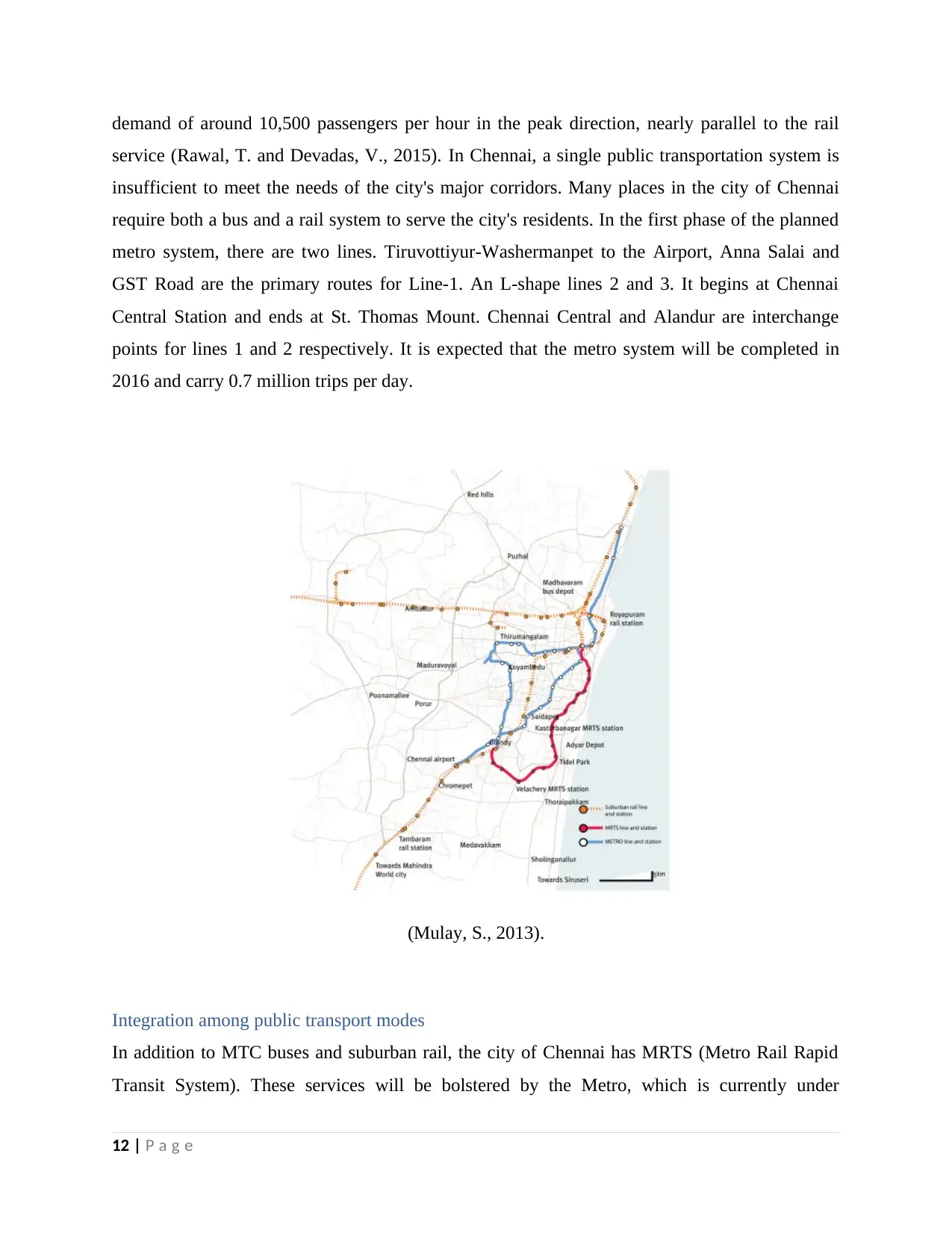
demand of around 10,500 passengers per hour in the peak direction, nearly parallel to the rail
service (Rawal, T. and Devadas, V., 2015). In Chennai, a single public transportation system is
insufficient to meet the needs of the city's major corridors. Many places in the city of Chennai
require both a bus and a rail system to serve the city's residents. In the first phase of the planned
metro system, there are two lines. Tiruvottiyur-Washermanpet to the Airport, Anna Salai and
GST Road are the primary routes for Line-1. An L-shape lines 2 and 3. It begins at Chennai
Central Station and ends at St. Thomas Mount. Chennai Central and Alandur are interchange
points for lines 1 and 2 respectively. It is expected that the metro system will be completed in
2016 and carry 0.7 million trips per day.
(Mulay, S., 2013).
Integration among public transport modes
In addition to MTC buses and suburban rail, the city of Chennai has MRTS (Metro Rail Rapid
Transit System). These services will be bolstered by the Metro, which is currently under
12 | P a g e
service (Rawal, T. and Devadas, V., 2015). In Chennai, a single public transportation system is
insufficient to meet the needs of the city's major corridors. Many places in the city of Chennai
require both a bus and a rail system to serve the city's residents. In the first phase of the planned
metro system, there are two lines. Tiruvottiyur-Washermanpet to the Airport, Anna Salai and
GST Road are the primary routes for Line-1. An L-shape lines 2 and 3. It begins at Chennai
Central Station and ends at St. Thomas Mount. Chennai Central and Alandur are interchange
points for lines 1 and 2 respectively. It is expected that the metro system will be completed in
2016 and carry 0.7 million trips per day.
(Mulay, S., 2013).
Integration among public transport modes
In addition to MTC buses and suburban rail, the city of Chennai has MRTS (Metro Rail Rapid
Transit System). These services will be bolstered by the Metro, which is currently under
12 | P a g e
⊘ This is a preview!⊘
Do you want full access?
Subscribe today to unlock all pages.

Trusted by 1+ million students worldwide
1 out of 21
Your All-in-One AI-Powered Toolkit for Academic Success.
+13062052269
info@desklib.com
Available 24*7 on WhatsApp / Email
![[object Object]](/_next/static/media/star-bottom.7253800d.svg)
Unlock your academic potential
Copyright © 2020–2025 A2Z Services. All Rights Reserved. Developed and managed by ZUCOL.


